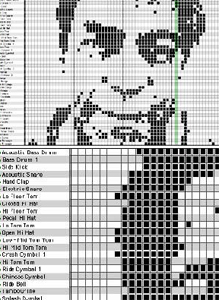
Just came across a passage in Daniel Albright's book Untwisting the Serpent: Modernism in Music, Literature, and the Other Arts that rang a bell: "...John Cage, a painter-in-sound...could refigure a Japanese garden as a trombone piece--or take the outline of Marcel Duchamp's profile, turn it ninety degrees, and instruct a performer to interpret the profile as a continuously varying musical line." (see Solos for Voice nos. 65 and 70)
The bell was Marcin Ramocki's Torcito Project, which digitally updates the Cage piece. Here's how Neural.it described it:
This work is composed of seven portraits made...in the summer of 2005 using Virtual Drummer, an "old" Macintosh software. A 48x64 grid is the canvas used by Ramocki. In this grid the bitmap image of a human face becomes the score of an endless sound loop. Each horizontal line corresponds to an instrument (for a total of 48 instruments) which is activated each time the cathode ray beam hits one of the portrait's pixels. Ramocki's work brings to mind Jacquard's punched cards, but also the pianola and the automatic piano.
To clarify somewhat, imagine a vertical line sweeping the face above. Each time it encounters a darkened pixel, a note from the "general MIDI" list (shown below the portrait) is played. The sweep begins quietly and is cacophonous by the time the cursor reaches the middle of the face. The general MIDI spec is heavy on percussion, so that's a lot of timbales, cowbells, etc., firing at once. The Albright book credits George Antheil, composer of Ballet Mecanique, as a forerunner of Cage in abstracting musical notes from their normal background and function. Ramocki injects the element of kitsch through the use of outmoded software and the somewhat rigid and dated MIDI assignments of notes to sounds. He has found a way to "play" an entire face, as opposed to just a profile.
